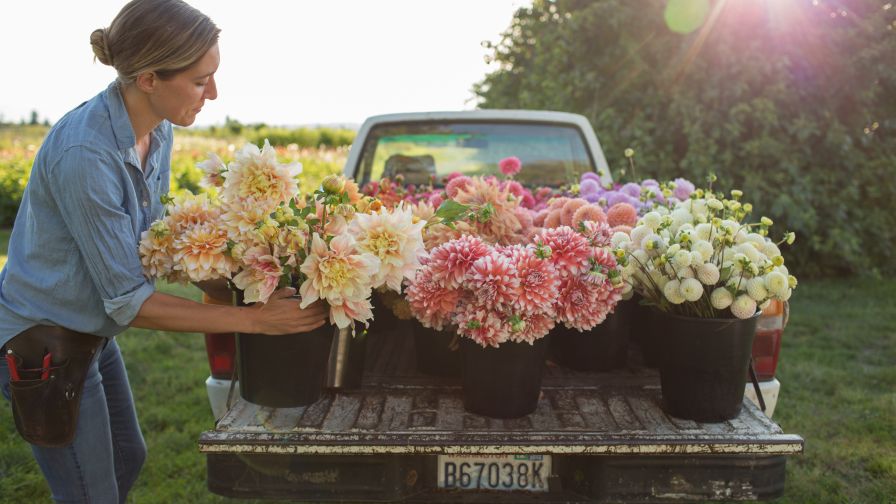
Erin Benzakein of Floret Flower Farm is featured in the Magnolia Network Series Growing Floret. The show follows Erin and her husband, Chris, as they grow their flower farm from 2 acres to 24 acres. Erin has also published a book for professional and home gardeners called Discovering Dahlias. Photo: Chris Benzakein, Floret
When the COVID-19 pandemic began, many people took the time to beautify their homes, inside and out. This led to a renewed interest in cut flowers. Industry experts thought cut flower sales would decline as the world settled into its “new normal,” but that hasn’t happened.
“Previously, we thought this would slowly decline as people returned to their normal habits of going out to eat more, going on holiday and using their income for other things. We thought this would slowly diminish,” says Dr. Melinda Knuth, Assistant Professor of Horticultural Science at North Carolina State University.
“However, due to the current economic conditions in the US and the ongoing threat of COVID-19 and financial pressures, we see this being maintained to some extent. It does not decrease. People continue to stay at home. They want to beautify their spaces and are not traveling as much this year,” he says.
Participation in Association of Specialist Cut Flower Growers has increased more than 100% in the past four years, according to Director of Education Rebecca Marrall. Knuth says she sees an explosion in local manufacturing.
There are many new cut flower growers with a few acres of production and selling to local grocers, farmers markets or providing flowers for local weddings. Knuth says it was most popular in California, Oregon and Washington, but now it’s everywhere. Also, the biggest international growers are maintaining their market share and expanding, he says.
But Knuth says it’s hard to recover from the Andean Trade Act, which was enacted in 1991. The law opened a 13-year period for South American countries to export agricultural products to the U.S. without tariffs. The domestic market took a big hit because imported products were much cheaper than domestic ones.
“We’ve seen a significant reduction,” says Knuth. “Domestic production accounted for almost 100% of sales. Now it’s 20%.”
Growers are getting creative and finding new ways to recruit and educate customers. For example, many cut flower growers offer educational resources to teach non-farmers how to grow a cut flower garden, Marrall says. These educational offerings include books, online courses, blogs, social media posts, and more. Agritourism starts with events like ‘Pick Your Own Flowers’, farm tours, ‘Make Your Own Bouquet’, glamping or overnight stays on the farm.
Florist businesses may also be on the rise because of popular culture, Marrall says. Erin Benzakein and her husband, Chris, of Floret Flower Farm are presented at Magnolia Network Series Growing Floret as they expand their farm in Washington’s Skagit Valley from 2 acres to 24 acres.

Nicole Pitt of Flower Hill Farm says her sales are up 25% from last year. Her bouquets are shown above. She attributes her success to her Facebook and YouTube posts. Photo: Flower Hill Farm
Growers thrive despite market challenges
Nicole Pitt’s Flower Hill Farm in Boonville, New York, says the pandemic has “fast forwarded” her business by five years. She opened Flower Hill Farm in 2018, but the pandemic gave her the time, capabilities and resources to grow the business.
Many growers recognize Pete from her YouTube Channel, Flower Hill Farm, which has more than 52,000 subscribers. She regularly shares updates about her farm, upcoming varieties and how she overcomes obstacles in her business.
Pitt says there are several popular trends this year. Soft palettes are always on trend for brides, but bold, bold colors are also popular. As the pandemic fades, consumers are looking for a cheerful bouquet to brighten their homes. The most requested flowers are lisianthus, ragus and sunflower, he says. Pitt has doubled its order of ranunculus for next year due to high demand this year.
“Everybody wanted it,” Pitt says of the ranunculus varieties. “It is an unknown flower for most customers. For my average customer, they’ve never seen it before.”
Even though the economy has hit a recession, Pitt says its sales are up 25 percent from last year. The US government reduced imports during the pandemic, Knuth says, and there has been an uptick in consumption.
“We don’t have enough flowers to meet the demand,” he says. “So many people were home trying to beautify their spaces and one of the ways they did that was with cut flowers.”
There were more weddings in 2022 than any other year in US history — 2.5 million, Knuth says. There were the regularly scheduled weddings for 2022, in addition to the rescheduled weddings from 2020 and 2021. The increase in weddings also contributed to the increase in cut flower demand.
Marrall says that cut flower farmers and growers who had a direct-to-consumer business model had to rely less on face-to-face sales channels like farmers markets, pop-up events and more. They pivoted and learned to incorporate social distancing into their practices, including online ordering, flower delivery, Community Supported Agriculture (CSA) memberships, and social distancing pickups.
Domestic growers have chosen to specialize in crops that allow them to differentiate themselves from large overseas producers who specialize in high-volume crops that have a long post-harvest life, Marrall says. Basics for North American cut flower growers include varieties of zinnias, lisianthus, and dahlias.
Some growers choose to develop further specialized operations in the specialty cut flower industry, such as crop-specific or consignment-based operations. For example, Ardelia Farm in Irasburg, VT, focuses exclusively on growing sweet peas. Southside Blooms in Chicago, IL, creates jobs for at-risk youth and young adults in urban settings, Marrall says.
Risks for New Growers
Knuth says it’s not a bad time to get into the cut flower market, but notes that this is a boom season and sales will continue to fluctuate.
“There is a lot of uncertainty over the next two to three years as to whether this flower demand will be sustained,” he says of the cut flower market.
For large-scale producers, Knuth says many inputs are required. However, for small farmers, the risks are not too great. Inputs don’t have to be high for a small grower to be successful. Small growers could sell their cut flowers at farmers’ markets or a local grocery store, for example.
Marrall says that aside from the weather and labor challenges, which all growers face, the biggest hurdle for new cut flower growers is the steep learning curve.
“These growers often have to learn how to start, grow, harvest and transport crops efficiently, while also learning how to run a business, which includes sales, marketing, legal and financial obligations, managing employees and more.” , says. “It can be an overwhelming array of topics to absorb.”
Pitt of Flower Hill Farm says growers should ask themselves, “What are you waiting for?” She quit her office job a year ago to grow cut flowers full time. There’s a lot of dirty work, he says, but growers should dip their toes in if they’re drawn to the cut flower market.
0
1
5
Cut flowers remain fashionable as the pandemic fades
Julie Hullett is the Managing Editor of Greenhouse Grower. See all author stories here.
